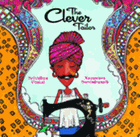
In Srividhya Venkat and Nayantara Surendranath's award-winning The Clever Tailor, the main character creates beautiful things from previously used fabric. This delightful story is based on an old Yiddish song. In today's global world, stories are shared in many ways; this song, already set down in several U.S. picture books, is refreshed in Venkat and Surendranath's Indian adaptation.
Poor in monetary resources, Rupa Ram takes a piece of golden fabric originally given to him as a saafa (a fancy wedding turban) and uses his skill to turns it into many different objects over time. When the turban wears out, Rupa Ram transforms the cloth into an odhni, a headscarf for his wife. After many uses, he takes pieces of the scarf to make a kurta (a long shirt) for his son and, eventually, salvages smaller scraps into a gudiya (doll) for his daughter. When the doll wears out, after much playing and hugging, Rupa Ram creates a gulaab, a decorative rose, for the whole family to enjoy. Finally, the tailor realizes that there is just enough fabric left to make something that can last forever: a kahaani, a story! Told in vivid prose with words from several Indian-subcontinent languages featured in a bold, large font colored the same as the fabric pattern (and defined in the glossary), the story works well as a read-aloud. The bright, fully saturated illustrations, in jewel-like tones with heavy black outlines, are amusingly warmhearted. An endnote explains the "philosophy behind the practice of upcycling," a strategy used for both utilitarian and creative purposes. --Melinda Greenblatt, freelance book reviewer

